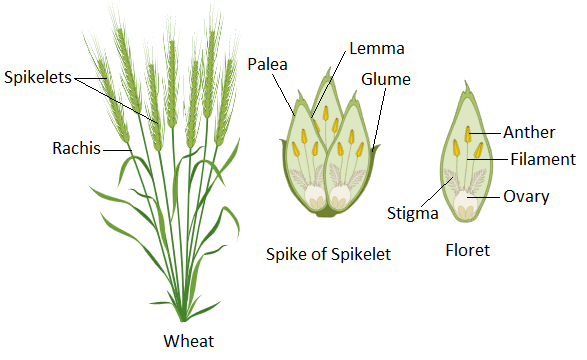
Spike of spikelet inflorescence is characteristic of
A. Asteraceae
B. Poaceae (Gramineae)
C. Brassicaceae
D. Malvaceae
Answer
465.9k+ views
Hint: Spikelet inflorescence is a type of elongated main-axis inflorescence which further is a type of racemose inflorescence. Spikelets are seen in grass species. Spikelets are represented by individual flower units. There is no calyx or corolla in a floret.
Complete answer: Inflorescence refers to the arrangement pattern of flowers attached to the main axis. There are mainly two types of inflorescences namely, racemose and cymose. The spike of spikelet inflorescence is a subtype of the racemose inflorescence. The racemose inflorescence is characterized by the continuous growth of the main axis and it does not terminate into flowers. It is also known as indefinite inflorescence. Flower buds are produced on the lateral sides of the main axis. The arrangement of flowers is in an acropetal manner. This means that flowers at the base are older and at the tip are younger. Elongated main axis inflorescence is a type of racemose inflorescence and spike of spikelet is a type of this inflorescence.

In the spike inflorescence, the main axis continues to grow without branching and flowers are without pedicel. The flowers are directly attached to the stalk. A compound type of spike is known as a spike of spikelets. The sessile flowers or spikelets which are without pedicel are present on the branched main-axis. This type of inflorescence is seen in wheat, barley, etc. which comes under grass species. The grass species are placed under the Poaceae family or Gramineae. Individual flower units are spikelets and the central axis to which they are attached is called the rachis. The spikelets together form a spike and that is why these are called spikelets.
Therefore, option B is the correct answer.
Note: Spikelets have glumes which are two scaly bracts at the base. The number of florets in a spikelet varies in different species. The florets have no corolla or calyx. The bracts enclose the reproductive organs of the floret. The external bract is larger and called lemma and the interior bract is smaller called palea.
Complete answer: Inflorescence refers to the arrangement pattern of flowers attached to the main axis. There are mainly two types of inflorescences namely, racemose and cymose. The spike of spikelet inflorescence is a subtype of the racemose inflorescence. The racemose inflorescence is characterized by the continuous growth of the main axis and it does not terminate into flowers. It is also known as indefinite inflorescence. Flower buds are produced on the lateral sides of the main axis. The arrangement of flowers is in an acropetal manner. This means that flowers at the base are older and at the tip are younger. Elongated main axis inflorescence is a type of racemose inflorescence and spike of spikelet is a type of this inflorescence.

In the spike inflorescence, the main axis continues to grow without branching and flowers are without pedicel. The flowers are directly attached to the stalk. A compound type of spike is known as a spike of spikelets. The sessile flowers or spikelets which are without pedicel are present on the branched main-axis. This type of inflorescence is seen in wheat, barley, etc. which comes under grass species. The grass species are placed under the Poaceae family or Gramineae. Individual flower units are spikelets and the central axis to which they are attached is called the rachis. The spikelets together form a spike and that is why these are called spikelets.
Therefore, option B is the correct answer.
Note: Spikelets have glumes which are two scaly bracts at the base. The number of florets in a spikelet varies in different species. The florets have no corolla or calyx. The bracts enclose the reproductive organs of the floret. The external bract is larger and called lemma and the interior bract is smaller called palea.
Recently Updated Pages
Express the following as a fraction and simplify a class 7 maths CBSE

The length and width of a rectangle are in ratio of class 7 maths CBSE

The ratio of the income to the expenditure of a family class 7 maths CBSE

How do you write 025 million in scientific notatio class 7 maths CBSE

How do you convert 295 meters per second to kilometers class 7 maths CBSE

Write the following in Roman numerals 25819 class 7 maths CBSE

Trending doubts
State and prove Bernoullis theorem class 11 physics CBSE

What are Quantum numbers Explain the quantum number class 11 chemistry CBSE

Write the differences between monocot plants and dicot class 11 biology CBSE

1 ton equals to A 100 kg B 1000 kg C 10 kg D 10000 class 11 physics CBSE

State the laws of reflection of light

In northern hemisphere 21st March is called as A Vernal class 11 social science CBSE




